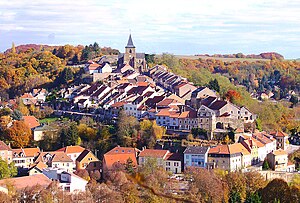Hombourg-Haut
| Hombourg-Haut | ||
|---|---|---|

|
|
|
| region | Grand Est | |
| Department | Moselle | |
| Arrondissement | Forbach-Boulay-Moselle | |
| Canton | Freyming-Merlebach | |
| Community association | Freyming-Merlebach | |
| Coordinates | 49 ° 8 ' N , 6 ° 47' E | |
| height | 209-354 m | |
| surface | 12.25 km 2 | |
| Residents | 6,433 (January 1, 2017) | |
| Population density | 525 inhabitants / km 2 | |
| Post Code | 57470 | |
| INSEE code | 57332 | |
| Website | http://www.hombourg-haut.fr/ | |
 medieval core of Oberhomburg |
||
Hombourg-Haut (German Oberhomburg , Lorraine Humerich ) is a French commune with 6,433 inhabitants (as of January 1, 2017) in the Moselle department in the Grand Est region ( Lorraine until 2016 ). Hombourg-Haut is part of the Forbach-Boulay-Moselle arrondissement .
The inhabitants call themselves Hombourgeois . Their nicknames are "The Humeriche Eichert" and "Bachwasser".
geography
Hombourg-Haut is on the edge of the Warndt between Saint-Avold and Freyming-Merlebach , near the border with Saarland . The community is surrounded by forests ( Forêt de Zang, Forêt de Steinberg ). The old town center lies on a rocky promontory above the Rossel valley .
Neighboring communities of Hombourg-Haut are Freyming-Merlebach in the northeast, Betting in the east, Guenviller in the southeast, Macheren in the south and Saint-Avold in the west and northwest.
history
Hombourg-Haut goes back to a castle built in the 10th century to protect the Abbey of Saint-Avold ("Altburg" near Hombourg-Bas). In 1254, Bishop Jakob von Metz founded a new castle and collegiate church on the opposite side of the valley, the nucleus of today's town of Hombourg-Haut. The castle settlement was fortified in a timely manner and received city rights in 1283 . In 1581, Hombourg-Haut fell to the Duchy of Lorraine, and thus to France in 1766. During the Thirty Years War , the castle was razed by French troops.
Population development
| year | 1962 | 1968 | 1975 | 1982 | 1990 | 1999 | 2007 | 2014 |
| Residents | 10.111 | 10,571 | 10,401 | 10,055 | 9580 | 9486 | 8048 | 6826 |
Attractions
- Former collegiate church of Saint-Étienne from the 14th century, is a listed building ( Monument historique ).
- Chapelle Sainte-Catherine (Katharinenkapelle) former castle chapel, from the 13th century, is under monument protection ( Monument historique ).
- Remains of the castle and the city walls
- Franciscan Recollect Monastery, from the 18th century
- Hellering castle ruin, from the 17th century, is a listed building ( Monument historique ).
Culture
music
- The Rencontres Musicales of the Festival International Théodore Gouvy have been taking place in Hombourg-Haut every year since 1989 . Five of the six concerts will be performed in the collegiate church of St-Étienne, the New Year's concert in the town hall.
- “Chœur d'hommes de Hombourg-Haut” (founded in 1865 ) is the oldest male choir in the former Lorraine region (dissolved in 2015).
Cultural event
- Carnival with a big street parade through the city center.
- Organ concerts in the collegiate church of St-Etienne. The former church organ was restored in 1906 by the organ builder Dalstein-Haerpfer .
partnership
- A partnership with the Italian municipality of San Giorgio di Pesaro in the Marche has existed since 1976 .
Transport links
Hombourg-Haut is on the national road 3 from Paris via Metz to Saarbrücken . The motorway and the railway line parallel to the RN3 also run through Hombourg-Haut.
Personalities
- Simon Batz , called Simon von Homburg (1420–1464), council syndic in Lübeck
- Anton Gapp (1766–1833), French Catholic priest and founder of an order of sisters, pastor in Hombourg from 1821 to 1833
- Théodore Gouvy (1819–1898), composer
- Fritz Münch (1906–1995), German international lawyer
Web links
- Official website of Hombourg-Haut
- The International Théodore Gouvy Festival Hombourg-Haut in the collegiate church of Saint Stephen (Collégiale Saint-Étienne): Male choir of the Alexander Nevsky Monastery in St. Petersburg (2013)
literature
- Friedrich Toepfer: Supplements II. Hombourg and Saint-Avold In: ders. (Ed.): Document book for the history of the noble and baronial house of the Voegte von Hunolstein , Bd. III. Ms. Campe, Nürnberg 1872, pp. 220–224 ( Google Books )
Individual evidence
- ^ Passé-Présent, La Moselle dévoilée, n ° 4, Novembre-Décembre 2011.
- ↑ History of the City


